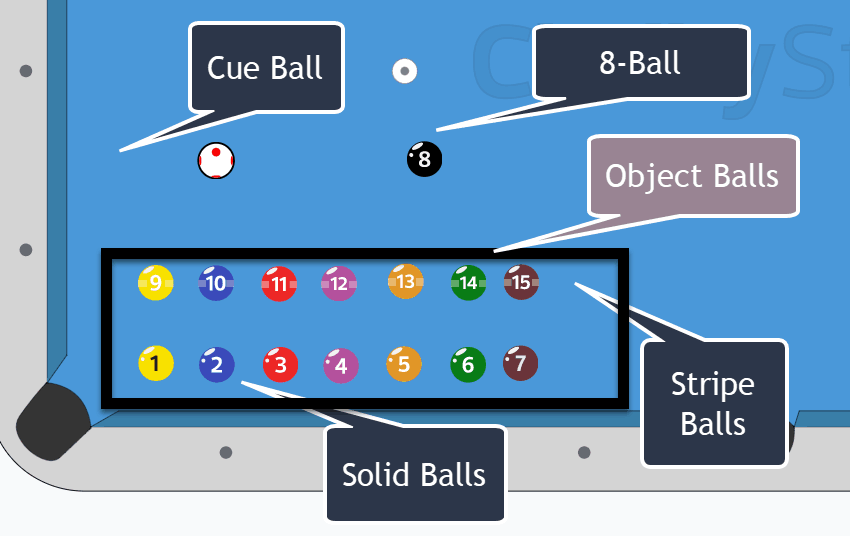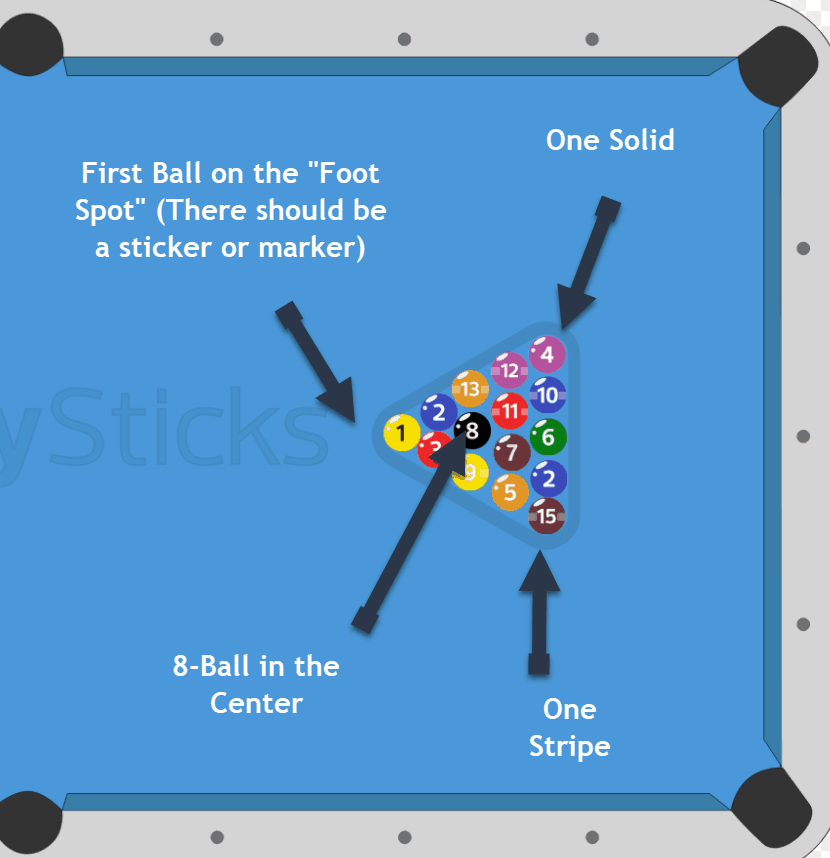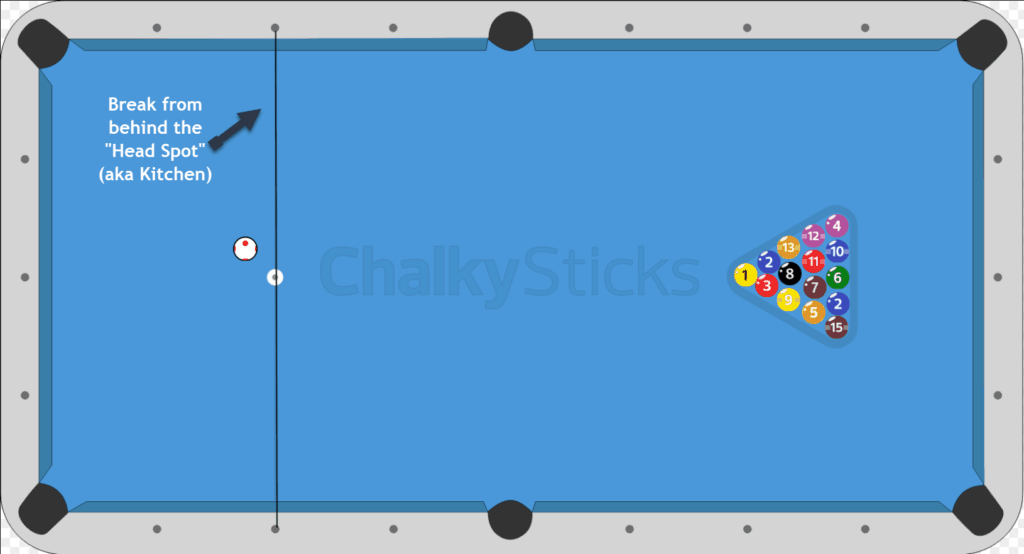The most popular American pocket billiard games is hands down – 8-ball.
The rules of the game are pretty simple. The first person to make all of their assigned groups (Solid or Stripes) of balls and then make the 8-ball in a designated or “called” pocket wins the game. Let’s break down some basic terminology before we move on.
Basic Definitions
We’ll go over some basic definitions so everyone is on the same page.
 Cue Ball = White ball
Cue Ball = White ball
Object Balls = 15 colored and numbered balls
-Solids = Numbered 1 through 7
-Stripes = Numbered 9 through 15
-8 Ball = Black ball numbered 8
Rail = The bank or walls within the box of the pool table (think of 4 walls in a room, but called Rails)
Scratch = When a player accidentally makes the cue ball into a pocket or commits a foul
Example: You are Solids but you accidentally hit a Stripe ball first
Pockets – There are 6 holes in which you can make the Object balls in called “Pockets”
- The 4 pockets in the corner are called Corner Pockets
- The 2 other remaining pockets on the sides are called Side Pockets
Cue/Cue Stick/Pool Stick – The main playing stick you use to strike the object balls
Quick Summary of 8-ball game
The pocket billiard game 8-ball is played with 15 object balls (labeled 1 through 15) and a cue ball (the white ball). Played with two players, whoever pockets their group of balls first (you can be SOLID – 1 through 7, or STRIPES – 9 through 15) and then pockets the 8-ball will win the game.
This is a call shot game, so you must call which ball you intend to make and the pocket it will go in. Failure to make it in the intended pocket forfeits your turn and it is now your opponent’s turn.
Universal Rules
(Regardless if you are playing bar rules or league rules – they are the same)
Most of the rules in all formats have some universal rules that are the same across the board. It may alter slightly from format to format.
- A player must sink their appropriate balls (Solid or Stripes), then pocket the 8-ball in the “called” pocket to win the game.
- The first player to make the 8-ball, wins the game.
- A player cannot shoot the 8-ball until all of their appropriate balls are pocketed first.
- If you make the 8-ball on the break without scratching, you instantly win.
How to Rack

You must “rack” or place the balls in a triangle at the “Foot” of the table with
- The 8-ball in the center
- A stripe ball in one corner of the rack
- A solid ball in the other corner of the rack and
- The first ball on the rack on the “Foot Spot”.
The rest of the balls don’t really matter where they go.
The Foot Spot usually has a black sticker or designated marked area.
What’s a “Tight Rack” or “Frozen”?
A Tight Rack – This means all the balls in the rack are touching without any space between the balls. This can also be called “Frozen”.
Be sure to make the rack “Tight” or “Frozen” which refers to each of the balls touching each other with no gaps. This ensures that the rack spreads better with energy transfer from your break is at a maximum.
Where to Break
The player who is breaking must break with the cue ball behind the “Head String”. This is also known as the Kitchen.
- This is also where the 2nd diamond is, so you can break from anywhere behind the 2nd diamond and there may be a sticker or spot to help you identify this area.

Image Correction: The Head Spot is supposed to be labeled the Head String*
If you want to know some common tips on how to improve your break, click here to go to my post about 5 ways to improve your breaking!
Common Bar Rules
These are common bar rules that I have come across. The rules in your bar may be different and that’s okay too. FYI (For your information, they may vary so please confirm with your opponent on all rules before proceeding with the game, it will save you future headaches later).
After the Break:
- Whatever you make is what you are (You made only solid balls on the break, you are solids for the remainder of the game)
- If you make the 8-ball and don’t scratch, you automatically win the game
- If you scratch or the cue ball flies off the table, your opponent must shoot from behind the Head String (in the Kitchen)
- The object ball they decide to hit from here must be beyond that head string too so you are hitting towards the longer side of the table
No “Ball-in-Hand”
- After a foul or table scratch has occurred, you just lose your turn and the cue ball stays where it is
- In other League formats, this would result in a Ball-In-Hand which means you can place the cue ball anywhere. A lot of bar players feel this is too much of an unfair advantage, I will leave that up to you guys to decide for yourselves!
Call Your Shots!
- A Player must call every single detail of how the ball is going to be pocketed or else the turn ends and it’s the opponents turn (Leave the cue ball where it stops naturally)
- This means if you make the Orange 5-Ball but it hit off of the Green 6-Ball but you didn’t say something along the lines of “5-Ball off the 6-Ball”, your turn is over even though you made your ball.
- Another example of this is if you call your Orange 5-Ball in the Corner Pocket but it misses, bounces and goes into the Side Pocket by accident. Sorry, you didn’t call the side pocket so – you got it, your turn is over!
Make the 8-Ball Clean
- Just like Calling Your Shots, you have to call which Pocket the 8-ball will go into
- No caroms allowed, only “Clean” shots so it can’t hit off another ball
- You can bank it off a rail
Carom – When you hit the ball you’re trying to make off of another ball and your original ball goes into a pocket
League Rules (APA vs. BCA)
The two most popular and well-known Billiard/Pool Leagues today are APA and BCA.
APA stands for American Poolplayers Association (Largest American billiard league with over 260,000 Members) and BCA stands for Billiard Congress of America. We’ll go over some of the biggest differences between the rules for APA and BCA. I will have a link below if you want to read all the rules for either league format.
With APA and BCA being the most popular, we will go over their most popular rules, differences and similarities.
| Situations | APA | BCA |
| After the Break | Whatever you make on the break is what you are | It is still “Open” and you can still choose between solid/stripes |
| Scratching (Only) After the Break | You must shoot from behind the Head Spot or Kitchen | You have Ball-In-Hand, take the cue ball and shoot from anywhere |
| Scratching or Table Scratch | Results in Ball-in-Hand | Results in Ball-in-Hand |
| Call Shots | You do not need to call any shots, “Slop” or “Lucky” shots count (Regardless of a Carom) | You must call each shot into each Pocket (Regardless of a Carom)
|
| 8-Ball Call Shot | You must “Mark” your 8-ball pocket with a “Marker” or “Object”.
Example: Cell phone, small toy, coin, etc. This is not always the case in League play as some players will just let you call or point to the pocket |
You must call the pocket you intend to make the 8-ball in (Regardless of a Carom). |
| Scratching on the 8-Ball | If you scratch on the 8-ball, that is an automatic loss | You do NOT lose! Your opponent just gets Ball-in-Hand and the game continue |
These are obviously not all the rules or differences between APA and BCA, but I wanted to go over the main ones. If you want to know the official rules for both APA and BCA, check out the links below to their official websites:
Major Differences:
So there are some slight differences between APA and BCA. The biggest takeaway I noticed are two rules:
- After the break – In APA, you are what you make. In BCA, it is “Open” and gives the player more options.
- If you scratch on the 8-ball – You lose in APA, but in BCA you do not.
If you are interested in how to find a nearby bar or league, check out my post that goes into detail called How to Find a nearby Bar, Tournament or Pool League.
Summary
Bar Rules or BCA Rules appear to be fairer to most players while APA is very forgiving because “Lucky” or “Slop” shots still count. There can be an argument made that since APA is the largest league for Amateurs and players need the handicap. This is a big debate between a lot of pool players and it’s common for players to complain about.
Be sure to choose the best format and rules for you to enjoy billiards. Most of the general rules are similar but there are slight tweaks.

